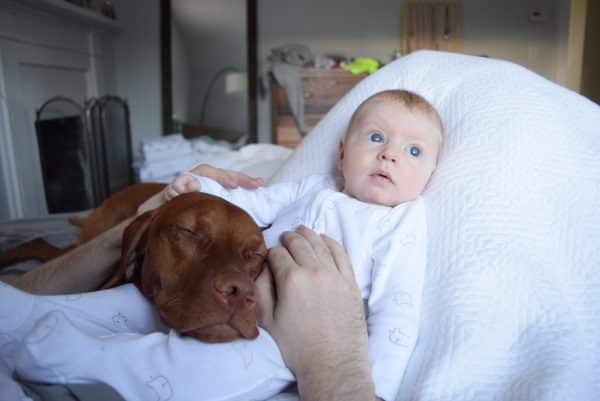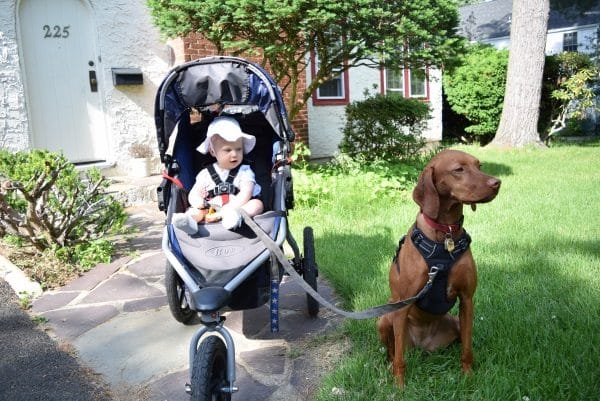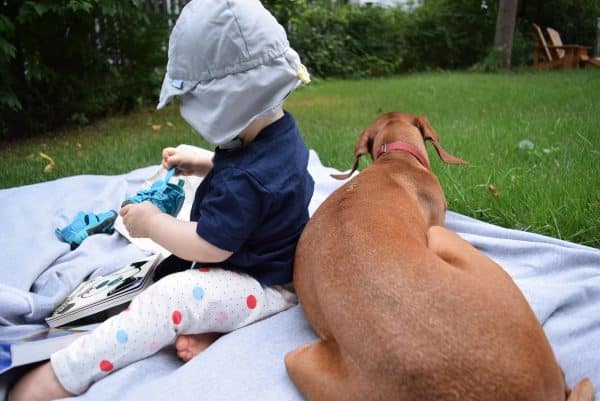“Pet her gently!” “Give Finley space!” “No swatting, please!” I spend most of my days playing zone defense between my active, always-wanting-to-play toddler and my equally active and always-wanting-to-play dog. As a parent to both human and furry children, I want nothing more than for them to like each other and get along. But I have to constantly manage their interactions because they’re both too young to understand things like being gentle and giving personal space. That kind of maturity and trust is still many, many years away. Plus, my dog, Finley, is super anxious by nature. So I asked leading pet expert Alyona DelaCoeur of Why Does My Dog for her tips on how to vigilantly supervise and proactively guide the five most frequent dog-toddler interactions in my home.
1. Toddler wants to pet the dog
My daughter frequently wants to pet Finley, but she’s not always as gentle as I’d like her to be. To work on making this kind of interaction safer, I’ve taken to keeping my dog’s head cradled in my hands while my daughter practices petting her on the neck and body. This seems to please both my daughter and my dog. DelaCoeur says I’m on the right path and should also give lots of treats with marker words like “Yesssssss” or “Gooooooood” that I should exaggerate to really hit the point home for my pup. I shouldn’t let my daughter hug the dog, but since Finley will often lick her in response to being close, I can allow that kind of closely monitored kiss if everyone seems comfortable. DelaCoeur just says I need to watch Finley for nervous body language, like bulging eyes, flat ears, heavy breathing and a tucked tail, and separate them if I see any of those behaviors.

2. Tot wants to feed the dog
My toddler daughter loves helping around the house and one of her favorite things to do is pour kibble into Finley’s feeder and even hand-feed her a little. DelaCoeur says that hand feeding is the best thing for fostering a good bond between child and dog. As long as my daughter is using an open hand and isn’t reaching into Finley’s bowl to get the food, I can let them enjoy this time together, while closely supervising of course. “Some other things that she can do with the dog during feeding is to leave a trail of food on the floor for the dog to follow around. She can also hide little piles of food for the dog to find and clean up,” DelaCoeur says, which sounds like a fun way to keep both of them busy. When my daughter has more language skills, I can also instruct her to have Finley stay and then release her once the food is in her feeder.
3. Both want to play tug-of-war
Both my dog and daughter desperately want to play tug-of-water together. If there’s a rope or plush toy within arm’s reach, one of them will grab it and coax the other to play. But a 19-month-old is way, way too young for this kind of roughhousing, so DelaCoeur suggests never leaving my dog and toddler alone (since I know they’ll engage with each other) and always playing with my own two hands on the toy at all times at a level that I’m comfortable with given their disparate size and strength. She also points to “conditioning” play, which means helping them play for about 20 seconds, then asking Finley to let go and lie down, or sit or give a paw before resuming play again. “This makes sure the dog never crosses the threshold,” she says.
4. Child wants to hold the leash
I take Finley for daily walks with my daughter, and recently she’s been wanting to hold the leash. I wasn’t sure if I should be allowing my child to “help” by holding the very end while I keep a firm grip closer to my dog. DelaCoeur says it’s fine and that I should include my daughter in as many bonding experiences with my dog as possible, as long as I keep control in case either one of them pulls on the leash. “Each time your dog is around your daughter, it should be the best time your dog can have. So, lots of loves and treats from you and lots of treats from your daughter,” she adds. But I should always keep in mind that if Finley needs space, we have to respect that and give it to her. Even if my daughter is begging to take her for a walk.

5. Little friends come over to play
I usually crate Finley when my daughter’s friends are over because kids are so unpredictable and I can’t control how other children are going to behave around or react to my dog. DelaCoeur assures me this is the smartest and safest thing to do, and that I should also make sure Finley’s time in the crate is pleasant and not a punishment. I always give Finley a treat for going into the crate, but I need to get into the habit of giving her something to chew on or a Kong filled with food or peanut butter. I also need to relocate the crate out of our living room and into our dining area, where kids won’t come right up to it and bother Finley in any way, DelaCoeur says. I can also consider putting up a baby gate to create an entirely safe zone for my pup.
Overall, I’m happy that my dog and child want to engage with one another and seem to enjoy each other’s company, but I know that I can never leave them together unsupervised. But that’s a good thing, because I don’t want to miss a moment of their sweet togetherness.

The post 5 Ways Your Toddler and Dog Want to Interact, and How to Help Keep Everyone Safe appeared first on Dogster.
No comments:
Post a Comment